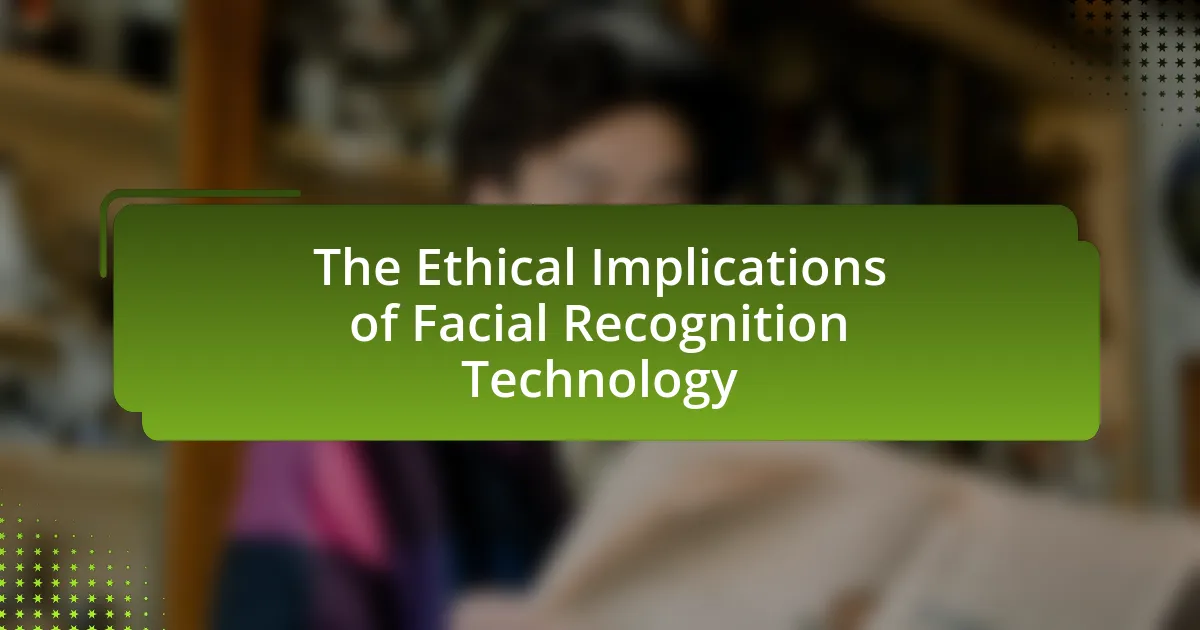Facial recognition technology (FRT) raises significant ethical implications, particularly concerning privacy, bias, and discrimination. The article examines how FRT can infringe on individual privacy rights through unauthorized surveillance and data misuse, highlighting the disproportionate impact on marginalized communities. It discusses the regulatory landscape across different jurisdictions, the societal consequences of FRT, and the ethical frameworks that can guide its responsible use. Additionally, the article addresses the challenges posed by advancements in AI and the role of public opinion in shaping regulations, while offering practical steps individuals can take to protect their privacy.

What are the Ethical Implications of Facial Recognition Technology?
The ethical implications of facial recognition technology include privacy concerns, potential for misuse, and issues of bias and discrimination. Privacy concerns arise as individuals may be monitored without consent, leading to a loss of anonymity in public spaces. Misuse can occur when the technology is employed for surveillance or tracking by governments or corporations, potentially infringing on civil liberties. Additionally, studies have shown that facial recognition systems often exhibit bias, particularly against marginalized groups, resulting in higher rates of misidentification and reinforcing existing societal inequalities. For instance, a 2019 study by the National Institute of Standards and Technology found that facial recognition algorithms had higher error rates for Asian and Black faces compared to White faces, highlighting the ethical need for equitable technology development and deployment.
How does Facial Recognition Technology impact privacy rights?
Facial recognition technology significantly impacts privacy rights by enabling the mass surveillance of individuals without their consent. This technology allows governments and private entities to collect, store, and analyze biometric data, often leading to unauthorized tracking and profiling of individuals. For instance, a study by the American Civil Liberties Union revealed that facial recognition systems misidentified people of color at a higher rate than white individuals, raising concerns about discrimination and privacy violations. Furthermore, the lack of comprehensive regulations governing the use of this technology exacerbates the risk of abuse, as seen in various instances where law enforcement agencies have deployed facial recognition without public knowledge or oversight.
What are the potential risks to individual privacy?
The potential risks to individual privacy include unauthorized surveillance, data breaches, and misuse of personal information. Unauthorized surveillance occurs when facial recognition technology is used without consent, allowing entities to track individuals’ movements and activities. Data breaches can expose sensitive biometric data, leading to identity theft and other privacy violations. Additionally, misuse of personal information can happen when collected data is used for purposes beyond the original intent, such as profiling or discrimination. According to a report by the Electronic Frontier Foundation, these risks highlight the need for stringent regulations and ethical guidelines surrounding the use of facial recognition technology to protect individual privacy rights.
How do different jurisdictions regulate privacy in facial recognition?
Different jurisdictions regulate privacy in facial recognition through a combination of laws, guidelines, and policies that vary significantly across regions. For instance, the European Union enforces the General Data Protection Regulation (GDPR), which mandates strict consent requirements and data protection measures for biometric data, including facial recognition. In contrast, the United States lacks a comprehensive federal law specifically governing facial recognition, leading to a patchwork of state-level regulations, such as California’s Consumer Privacy Act, which provides consumers with rights regarding their personal data. Additionally, some cities, like San Francisco, have enacted outright bans on the use of facial recognition by city agencies, reflecting local concerns about privacy and civil liberties. These regulatory approaches illustrate the diverse landscape of privacy protections related to facial recognition technology across different jurisdictions.
What are the societal implications of Facial Recognition Technology?
Facial Recognition Technology (FRT) has significant societal implications, primarily concerning privacy, security, and discrimination. The widespread deployment of FRT in public spaces raises concerns about surveillance and the erosion of individual privacy rights, as studies indicate that over 70% of Americans express discomfort with being monitored by such systems. Additionally, FRT can exacerbate existing biases; research from the MIT Media Lab found that facial recognition systems misidentified darker-skinned individuals at rates up to 34.7%, compared to 0.8% for lighter-skinned individuals, highlighting the potential for systemic discrimination. Furthermore, the use of FRT by law enforcement can lead to wrongful arrests and a lack of accountability, as evidenced by cases where misidentification has resulted in legal repercussions for innocent individuals. These implications necessitate careful consideration of ethical frameworks and regulatory measures to mitigate risks associated with FRT.
How does facial recognition affect marginalized communities?
Facial recognition technology disproportionately affects marginalized communities by increasing surveillance and the likelihood of misidentification. Studies have shown that these systems often exhibit higher error rates for individuals with darker skin tones, leading to wrongful accusations and heightened police scrutiny. For instance, a 2019 study by the National Institute of Standards and Technology found that facial recognition algorithms misidentified Black individuals at rates up to 100 times higher than white individuals. This systemic bias exacerbates existing inequalities, as marginalized groups face greater risks of harassment and discrimination in law enforcement contexts.
What role does bias play in facial recognition algorithms?
Bias significantly impacts facial recognition algorithms by leading to inaccuracies in identification and classification, particularly among marginalized groups. Studies, such as those conducted by the MIT Media Lab, have shown that facial recognition systems exhibit higher error rates for individuals with darker skin tones, women, and younger people. For instance, the research revealed that the error rate for dark-skinned women was as high as 34.7%, compared to just 0.8% for light-skinned men. This bias arises from unrepresentative training datasets, which often lack diversity, resulting in algorithms that perform poorly on underrepresented demographics. Consequently, the presence of bias in these algorithms raises ethical concerns regarding fairness, accountability, and the potential for discrimination in real-world applications.
What ethical frameworks can be applied to Facial Recognition Technology?
Utilitarianism, deontological ethics, and virtue ethics are key ethical frameworks applicable to Facial Recognition Technology (FRT). Utilitarianism evaluates the consequences of FRT, focusing on maximizing overall happiness while minimizing harm, such as privacy violations or wrongful identifications. Deontological ethics emphasizes adherence to rules and duties, highlighting the importance of consent and individual rights in the deployment of FRT. Virtue ethics considers the character and intentions of those implementing FRT, advocating for responsible use that aligns with societal values. These frameworks collectively guide the ethical considerations surrounding the deployment and regulation of facial recognition systems.
How do utilitarian principles apply to facial recognition use?
Utilitarian principles apply to facial recognition use by evaluating the technology based on its ability to maximize overall happiness and minimize harm. This assessment considers the benefits of enhanced security, crime prevention, and efficiency in various sectors against potential drawbacks such as privacy invasion, discrimination, and misuse of data. For instance, a study by the National Institute of Standards and Technology found that facial recognition systems can significantly improve law enforcement’s ability to identify suspects, potentially leading to safer communities. However, the same technology has been criticized for disproportionately misidentifying individuals from minority groups, which can lead to unjust consequences. Thus, utilitarian analysis requires a careful balance between the positive outcomes of facial recognition and the ethical implications of its negative impacts on society.
What are the deontological considerations regarding consent?
Deontological considerations regarding consent emphasize the moral obligation to respect individuals’ autonomy and their right to make informed decisions about their personal data. In the context of facial recognition technology, this means that individuals must be fully aware of how their biometric data will be used and must provide explicit consent before any data collection occurs. The principle of informed consent is crucial, as it ensures that individuals understand the implications of their consent, including potential risks and benefits. Furthermore, deontological ethics asserts that consent must be given freely, without coercion or manipulation, reinforcing the importance of ethical practices in technology deployment.
How can we ensure ethical use of Facial Recognition Technology?
To ensure ethical use of Facial Recognition Technology, it is essential to implement strict regulations and guidelines that govern its deployment. These regulations should include transparency requirements, where organizations must disclose how facial recognition data is collected, stored, and used. Additionally, independent audits should be conducted to assess compliance with ethical standards and to mitigate biases inherent in the technology. For instance, a study by the National Institute of Standards and Technology found that facial recognition algorithms can exhibit significant demographic disparities, highlighting the need for oversight to prevent discrimination. Furthermore, public engagement and consent should be prioritized, allowing individuals to opt-in or opt-out of facial recognition systems. This approach not only fosters accountability but also builds trust between technology providers and the public.
What best practices should organizations follow when implementing this technology?
Organizations should prioritize transparency and accountability when implementing facial recognition technology. This involves clearly communicating the purpose, scope, and limitations of the technology to stakeholders, including employees and the public. Additionally, organizations should establish robust data governance policies to ensure compliance with privacy laws and ethical standards. For instance, a study by the National Institute of Standards and Technology (NIST) highlights that organizations using facial recognition must implement bias mitigation strategies to prevent discrimination and ensure fairness. Regular audits and assessments of the technology’s impact on privacy and civil liberties are also essential to maintain ethical integrity and public trust.
How can transparency and accountability be maintained in facial recognition systems?
Transparency and accountability in facial recognition systems can be maintained through rigorous regulatory frameworks and public oversight. Implementing clear guidelines that dictate the use, data handling, and operational protocols of these systems ensures that stakeholders are held accountable for their actions. For instance, the General Data Protection Regulation (GDPR) in Europe mandates transparency in data processing, requiring organizations to inform individuals about how their data is used, which can be applied to facial recognition technologies. Additionally, independent audits and assessments can be conducted to evaluate compliance with ethical standards and legal requirements, thereby fostering trust and accountability. Studies have shown that public engagement and feedback mechanisms can further enhance transparency, allowing communities to voice concerns and influence policy decisions regarding the deployment of facial recognition systems.
What are the future challenges for ethical Facial Recognition Technology?
Future challenges for ethical Facial Recognition Technology include issues of privacy, bias, accountability, and regulatory compliance. Privacy concerns arise as individuals may be monitored without consent, leading to potential violations of personal freedoms. Bias is a significant challenge, as studies have shown that facial recognition systems can misidentify individuals from certain demographic groups, resulting in discriminatory outcomes. Accountability is crucial, as the deployment of this technology often lacks clear guidelines on who is responsible for misuse or errors. Regulatory compliance is also a challenge, as governments worldwide are still developing frameworks to govern the ethical use of facial recognition, creating uncertainty for developers and users alike. These challenges highlight the need for robust ethical standards and regulations to ensure responsible use of facial recognition technology.
How might advancements in AI affect ethical considerations?
Advancements in AI will significantly impact ethical considerations by raising concerns about privacy, bias, and accountability. As AI technologies, particularly in facial recognition, become more sophisticated, they can lead to increased surveillance and potential misuse of personal data, which challenges individual privacy rights. For instance, a study by the American Civil Liberties Union found that facial recognition technology misidentified people of color at a rate of up to 34%, highlighting the risk of bias in AI systems. Furthermore, the lack of transparency in AI decision-making processes complicates accountability, as it becomes difficult to determine who is responsible for errors or misuse of the technology. These factors necessitate a reevaluation of ethical frameworks to ensure that advancements in AI align with societal values and human rights.
What role will public opinion play in shaping regulations?
Public opinion will significantly influence the shaping of regulations regarding facial recognition technology. As societal attitudes evolve, policymakers often respond to public concerns about privacy, surveillance, and ethical implications, leading to the development of more stringent regulations. For instance, in 2020, cities like San Francisco and Boston enacted bans on facial recognition technology, reflecting public apprehension about its potential misuse and impact on civil liberties. This demonstrates that when a substantial portion of the population expresses concern, it can prompt legislative action to address those issues, thereby shaping the regulatory landscape.
What practical steps can individuals take to protect their privacy from Facial Recognition Technology?
Individuals can protect their privacy from Facial Recognition Technology by using methods such as wearing masks or face coverings, which can obscure facial features and hinder recognition systems. Additionally, individuals should limit the sharing of personal images on social media platforms, as these can be used to train facial recognition algorithms. Utilizing privacy-focused applications that block or limit tracking can further enhance privacy. Furthermore, individuals can advocate for legislation that regulates the use of facial recognition technology, as seen in cities like San Francisco, which have enacted bans on its use by government agencies. These steps collectively contribute to reducing the risk of unauthorized facial recognition and enhance personal privacy.



